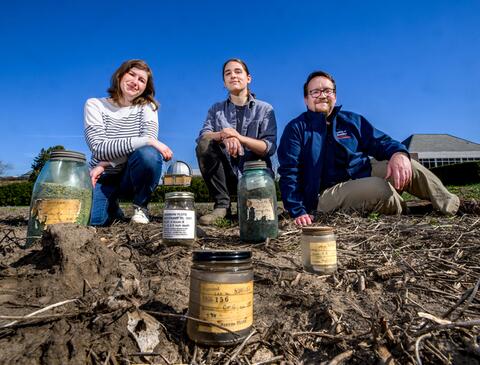Oldest US agricultural plots go digital: 130+ years of data now online

URBANA, Ill. – In 1876, when University of Illinois professor Manly Miles established the Morrow Plots, he couldn’t have imagined the plots would become the oldest continuous agricultural experiment in the Western Hemisphere. Nor could he imagine, more than a century before the dawn of the internet, that the plots’ data would be digitized and made available online to scientists, students, and educators around the world.
The new database, which includes crop hybrid, rotation, planting density, and yield, as well as fertilizer type and amount, came together thanks to the Morrow Plots Data Curation Working Group, an interdisciplinary team from the College of Agricultural, Consumer and Environmental Sciences (ACES) and the University Library at U of I.
Data scientists and curators not only had to find the historical data, including in an ancient notebook held by the Department of Crop Sciences, they had to standardize it through time so that year-to-year comparisons could be made. For example, some data were missing for certain years and yield wasn’t recorded at all until 1888. Thankfully, the working group was up for the challenge.
 L to R: Professor Sandi Lee Caldrone, research technician Maia Rothman, and Associate Director of Information Technology Josh Henry.
L to R: Professor Sandi Lee Caldrone, research technician Maia Rothman, and Associate Director of Information Technology Josh Henry.
Sandi Caldrone, assistant professor and University Library research data librarian, says, “The data were all in slightly different formats and needed a lot of finagling to get them to line up. My role was doing the coding required to clean up and combine those data sets and get it ready to publish. I also did a lot of the accompanying documentation that explains how we did it for folks who want to use the data or reproduce our work.”
Josh Henry, associate director of information technology for ACES, initially kickstarted the project in 2018 as an example for faculty wanting to curate their own research data. As few faculty have such long and complex datasets, he knew if the working group could pull it off with the Morrow Plots data, anyone could do it.
“We learned a lot of lessons about how to deal with really messy data,” Henry says. “We now feel confident explaining what challenges have to be met in order to take something that was perhaps less useful and turning it into something that will be valuable for the future.”
Prior to the database’s publication, Andrew Margenot was fielding dozens of requests for the Morrow Plots data each year. Now he can direct those requests to the Illinois Data Bank.
“I’ve gotten requests from government and university researchers, both in the U.S. and abroad. They’re mainly modelers trying to link weather patterns with yield and soil data; a lot of modelers salivate at the Morrow Plots data,” says Margenot, assistant professor in crop sciences. “We also get requests from folks trying to understand how their long-term trials compare with ours.”
Margenot says the data can also be used to understand how soil fertility is influenced by management practices of crop rotation and nutrient inputs, and how this relates to crop yields. After discovering a trove of historic soil samples from the Morrow Plots and other sites around Illinois, Margenot is eager to analyze long-term trends.
Caldrone hopes the data can also be used for educational purposes.
“Students in every field need to learn how to work with data now,” she says. “As instructors need to find datasets to work into their classes, I would love to see people using the Morrow Plots data. It's a longitudinal data set, and I think students in any field can get a grasp of the basics of planting, fertilization, and yield. And then, for U of I students, they learn a little bit more about their university history.”
The Morrow Plots started as an experiment to test the effects of crop rotation on soil quality, but along the way, they helped establish a number of farming basics we take for granted today, including that crops require nitrogen, phosphorus, and potassium; hybrid corn can boost yield, especially when planted at close spacing; and crop rotation can mean less need for fertilizers.
“The lesson of the Morrow Plots is clear: conserve the soil and maintain proper soil fertility to sustain food production for future generations,” says Robert Dunker, ACES agronomist and field trials coordinator. “Results from the Morrow Plots have given insights on how crop production systems respond to rotation and soil fertility, shaping farming practices to this day. While the Morrow Plots have become a significant historical site, they remain a continuing opportunity for researchers and student education.”